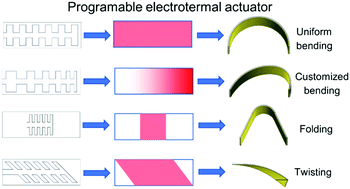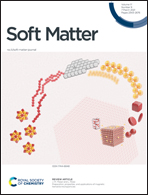Programmable soft electrothermal actuators based on free-form printing of the embedded heater†
Abstract
In recent years, there has been an increasing interest in the research in soft actuators that exhibit complex programmable deformations. Soft electrothermal actuators use electricity as the stimulus to generate heat, and the mismatch between the thermal expansions of the two structural layers causes the actuator to bend. Complex programmable deformations of soft electrothermal actuators are difficult due to the limitations of the conventional fabrication methods. In this article, we report a new approach to fabricate soft electrothermal actuators, in which the resistive heater of the electrothermal actuator is directly printed using electrohydrodynamic (EHD) printing. The direct patterning capabilities of EHD printing allow the free-form design of the heater. By changing the design of the heating pattern on the actuator, different heat distributions can be achieved and utilized to realize complex programmable deformations, including uniform bending, customized bending, folding, and twisting. Finite element analysis (FEA) was used to validate the thermal distribution and deformation for different actuator designs. Lastly, several integrated demonstrations are presented, including complex structures obtained from folding, a two-degree-of-freedom soft robotic arm, and soft walkers.



 Please wait while we load your content...
Please wait while we load your content...